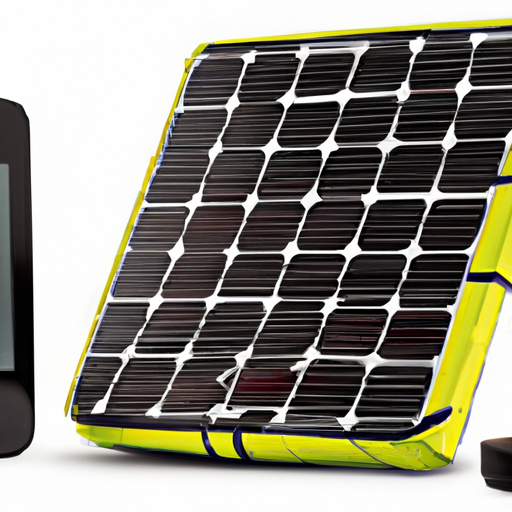

Have you ever wondered how solar power banks prevent overcharging and overheating? It’s a valid concern, especially when it comes to the safety of our electronic devices. Well, you’re in luck because in this article, we’ll dive into the various safety features that are put in place to ensure that your solar power bank remains efficient and safe to use.
One of the key safety features in solar power banks is overcharge protection. This feature safeguards your devices by preventing the battery from being charged beyond its safe limit. It does this by automatically stopping the charging process once the battery is fully charged. This not only protects your devices from potential damage but also prolongs the lifespan of your solar power bank. In addition to overcharge protection, most solar power banks also come equipped with overheat protection. This feature monitors the internal temperature of the power bank and takes action to prevent overheating. It does so by either reducing the charging speed or by automatically shutting down the power bank if it reaches a certain temperature. This protects both your devices and the power bank itself from potential risks such as battery swelling or even explosions. So, next time you’re using your solar power bank, you can rest assured knowing that these safety features are actively working to keep your devices and the power bank itself safe from any potential harm.


Understanding Solar Power Banks
Solar power banks are portable devices that harness the power of the sun to charge electronic devices such as smartphones, tablets, and cameras. They are equipped with photovoltaic panels that convert sunlight into electric energy, which is then stored in rechargeable batteries for later use. This makes them an ideal solution for outdoor activities or situations where access to a traditional power source is limited.
How do solar power banks work?
Solar power banks work by capturing sunlight through the photovoltaic panels. These panels are usually made of multiple solar cells that contain a semiconductor material, typically silicon. When sunlight hits the solar cells, the photons in the sunlight excite the electrons in the semiconductor, creating a flow of electricity. This electricity is then harnessed and stored in the batteries within the power bank.
Solar power banks typically have a built-in circuitry system that regulates and controls the flow of electricity. This ensures that the batteries are charged efficiently and safely. However, without proper safety features, overcharging and overheating can occur, posing risks to both the power bank itself and the devices being charged.
Risks Associated with Overcharging and Overheating
Overcharging a solar power bank can cause the batteries to deteriorate or fail prematurely. When a power bank is overcharged, excess electrical energy can cause the batteries to heat up, resulting in a higher risk of overheating. Additionally, overcharging can lead to voltage spikes, which can damage electronic devices that are connected to the power bank.
Overheating is another concern when it comes to solar power banks. Excessive heat can cause damage to the internal components and circuits of the power bank, reducing its lifespan and potentially rendering it unusable. Overheating can also pose a fire hazard if not properly managed.
Safety Features to Prevent Overcharging
To prevent overcharging, solar power banks are equipped with various safety features. These safety features are designed to regulate and control the charging process, ensuring that the batteries are charged to their optimal levels without the risk of overcharging.
Automatic shut-off mechanism
One common safety feature found in solar power banks is an automatic shut-off mechanism. This mechanism detects when the batteries are fully charged and automatically stops the charging process, preventing any further charging and potential overcharging. This feature ensures that the power bank is not continuously exposed to excessive electrical energy.
Voltage regulation circuit
Solar power banks also include a voltage regulation circuit, which helps maintain a consistent output voltage during the charging process. This circuitry ensures that the batteries are charged at the appropriate voltage, preventing overcharging and voltage spikes that could damage connected devices. It helps to provide a stable and safe charging experience.
Overcurrent protection
Overcurrent protection is another safety feature that prevents excessive currents from flowing into the power bank and its batteries. This feature detects when the current exceeds a safe threshold and automatically cuts off the charging process. By cutting off the flow of current, it protects the power bank from damage and reduces the risk of overheating or other safety hazards.


Safety Features to Prevent Overheating
Overheating can be a major concern when using solar power banks, but manufacturers have incorporated various safety features to mitigate this risk.
Thermal sensors
Many solar power banks are equipped with thermal sensors that monitor the temperature of the power bank. These sensors can detect when the temperature rises to a dangerous level and trigger an automatic shut-off mechanism to prevent further charging and reduce the risk of overheating. Thermal sensors help ensure the safe operation of the power bank even in high-temperature environments.
Heat dissipation technology
Heat dissipation technology is also an important safety feature in solar power banks. This technology involves the use of heat sinks, heat pipes, or other cooling mechanisms to dissipate excess heat generated during charging. By dispersing the heat away from the internal components, heat dissipation technology helps prevent overheating and prolongs the lifespan of the power bank.
Importance of Safety Features in Solar Power Banks
The presence of safety features in solar power banks is crucial for several reasons.
Protection of electronic devices
One of the primary purposes of using a solar power bank is to charge electronic devices, and the safety of these devices should never be compromised. Safety features such as overcurrent protection and voltage regulation circuits help prevent damage to connected devices by ensuring a stable and safe charging environment. By protecting electronic devices from overcharging and voltage spikes, these safety features help safeguard valuable and often expensive gadgets.
Prolonging the lifespan of the power bank
Safety features not only protect the devices being charged but also contribute to the longevity of the solar power bank itself. Overcharging and overheating can significantly reduce the lifespan of the power bank, rendering it useless after a short period. With safety features in place, the power bank is protected from excessive electrical energy, voltage spikes, and high temperatures, ensuring its durability and long-term usability.
Testing and Certification Standards
To ensure the safety and reliability of solar power banks, various testing procedures and certification standards have been put in place.
Testing procedures for overcharging and overheating
During the testing phase, solar power banks undergo rigorous assessments to determine their performance under different circumstances, including testing for overcharging and overheating. These tests evaluate the effectiveness of the safety features and ensure that the power banks adhere to international safety standards.
Certifications to look for in a solar power bank
When purchasing a solar power bank, it is essential to look for certifications that guarantee its safety and quality. Certifications such as CE (Conformité Européene) and FCC (Federal Communications Commission) indicate that the power bank has passed specific safety tests and meets the required standards. These certifications provide assurance that the solar power bank has been thoroughly tested and deemed safe for use.
Common User Errors that Compromise Safety
While solar power banks come equipped with safety features, user errors can still compromise the safety of these devices.
Leaving the power bank under direct sunlight for extended periods
Leaving a solar power bank exposed to direct sunlight for extended periods can lead to overheating. Continuous exposure to intense sunlight can increase the internal temperature of the power bank, potentially damaging the batteries and other components. It is recommended to place the power bank in a shaded area when not in use to prevent overheating and prolong its lifespan.
Using incompatible chargers or cables
Using incompatible or low-quality chargers and cables can also compromise the safety of solar power banks. These chargers and cables may not provide the necessary voltage or current required for safe and efficient charging. It is important to use chargers and cables that are specifically designed for the power bank to ensure compatibility and minimize the risk of overcharging or overheating.
Care and Maintenance Tips
Proper care and maintenance of solar power banks are essential to ensure their continued safety and performance.
Avoiding extreme temperatures
Solar power banks should be kept away from extreme temperatures, whether hot or cold. High temperatures can lead to overheating, as mentioned earlier, while low temperatures can affect the efficiency and performance of the batteries. It is advisable to store the power bank in a cool and dry place to prevent damage caused by temperature fluctuations.
Regularly cleaning and inspecting the power bank
Dust, dirt, and other particles can accumulate on the surface and vents of the power bank, hindering heat dissipation and potentially causing overheating. Regularly cleaning the power bank with a soft cloth and inspecting it for any signs of damage or wear is important. Cracks or bulges in the casing should be addressed immediately to prevent any safety hazards.
Comparing Safety Features in Different Solar Power Banks
When choosing a solar power bank, it is crucial to compare the safety features offered by different models and manufacturers. This ensures that you select a power bank that meets your safety requirements and provides peace of mind.
Researching product specifications
Product specifications provide information about the safety features incorporated into a solar power bank. These may include details about overcurrent protection, voltage regulation circuits, automatic shut-off mechanisms, thermal sensors, and heat dissipation technology. By carefully examining the product specifications, you can assess the safety features and determine if they meet your needs.
Reading customer reviews
Customer reviews can offer valuable insights into the safety features and overall performance of a solar power bank. Reading reviews from other users can help you understand how well the safety features function in real-world scenarios and whether they provide adequate protection against overcharging and overheating.
Conclusion
As the demand for portable power sources continues to rise, solar power banks have become a popular choice for outdoor enthusiasts and individuals seeking reliable charging solutions. However, the importance of safety features in solar power banks cannot be understated. Investing in a reliable and certified solar power bank with robust safety mechanisms ensures the protection of your devices and enhances the lifespan of the power bank. By understanding the safety features in place to prevent overcharging and overheating, you can make an informed decision when selecting a solar power bank and enjoy worry-free charging wherever you go.



